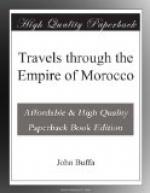Salee is a walled town, strongly defended by a large battery, mounting twenty-four pieces of heavy ordnance, and a redoubt which protects the mouth of the river. It contains about five hundred regular troops, three thousand militia-men, five hundred sailors, and a number of Moorish merchants and Jews. To the north of this garrison is a small town, in a ruinous state, inhabited by a few negro families. I was told it was built by Muley Ishmael for the accommodation of his favourite black troops. To the south, and on the opposite side of the river Salee, is the maritime city of Rabat, commanded by a black chief, and garrisoned with black soldiers.
It is defended by a fort and strong batteries, adequate to prevent a hostile landing. It contains several ruins of importance; among the most conspicuous of which are those of a large mosque, and the famous castle built by Almansor the Invincible, together with a superb square tower; which latter is still in a tolerable state of preservation, and is called the tower of Hassen. This tower is about two hundred feet in height, strongly built with cut stone, and most curiously decorated with Arabic characters. It contains a staircase of easy ascent to the top, whence I had a most extensive prospect of the Atlantic Ocean, where vessels are descried sailing at an immense distance.
The walls of Rabat are nearly two miles in circumference, and fortified by several square towers. Exclusive of its regular garrison, it contains four thousand militia-men, and about fifteen hundred sailors, besides several Moorish merchants and Jews; which latter live in a separate quarter.
This town, as well as Salee, is admirably calculated for trade, capable of furnishing foreign markets with large quantities of wool, leather, wax, and other important commodities. These contiguous cities are surrounded by gardens, watered by plentiful streams, which are artificially conveyed from a neighbouring spring, that takes its rise in a valley called Tamura, to the south of Rabat, and which also supplies all the houses of the two towns with fresh water.
Both places contain docks for building vessels, and several small corvettes in the Emperor’s service winter in these harbours: but the roads, like those of Larache, are only to be frequented from the beginning of April to the end of September, on account of the shifting of the sand, which accumulates on the wind blowing from the south-west, when the bar is rendered unsafe for vessels to pass. Too great attention cannot be paid by commanders or masters of ships, on anchoring there, as a great number of anchors have been lately lost, and many vessels stranded.
Curiosity prompted me to inspect a small ruinous town to the east of Rabat, named Shella, supposed to have been built by the Carthaginians: but my approach was rudely prevented by the inhabitants; no Christian, nor even Jew, being suffered to enter, on account of its containing several tombs of their most celebrated saints, while in fact it is only a sacred asylum for malefactors, and all the rogues of the country.




